The Economics and Statistics Division maintains archives of previous publications for accountability purposes, but makes no updates to keep these documents current with the latest data revisions from Statistics Canada. As a result, information in older documents may not be accurate. Please exercise caution when referring to older documents. For the latest information and historical data, please contact the individual listed to the right.
<--- Return to Archive
For additional information relating to this article, please contact:
November 28, 2023GOVERNMENT EXPENDITURE BY FUNCTION, 2022 Statistics Canada has published details from Consolidated Government Finance Statistics for 2022 including consolidated results for provincial-territorial and local governments by nine functional areas of expenditure: health care, education, social protection, general public service (which includes debt payments), economic affairs (which includes transportation), public order/safety, environmental protection (which includes wastewater and solid waste), housing/community amenities (which includes water services) and recreation/culture.
Details on defence spending are provided only at the Federal level. Annual data correspond to the end of the fiscal year closest to December 31. For example, data for the fiscal year ending on March 31, 2023 (fiscal year 2022-23) are reported as the 2022 reference year. Per capita expenditures are calculated using the population as of July 1 during the fiscal year; for fiscal year 2022-23, per capita expenditures are calculated using the population as of July 1, 2022.
These data are based on the international government financial statistical standard and, as such, may differ in their presentation from similar concepts reported in Public Accounts and other financial statements. Statistics Canada's data allows for comparability across jurisdictions.
Total per capita expenditures by provincial-local government function added up to $16,430 in Nova Scotia, $414 per capita below the provincial-local government average in 2022 ($16,844). Ontario had lowest per capita expenditure among provinces. Saskatchewan reported the highest expenditures per capita.
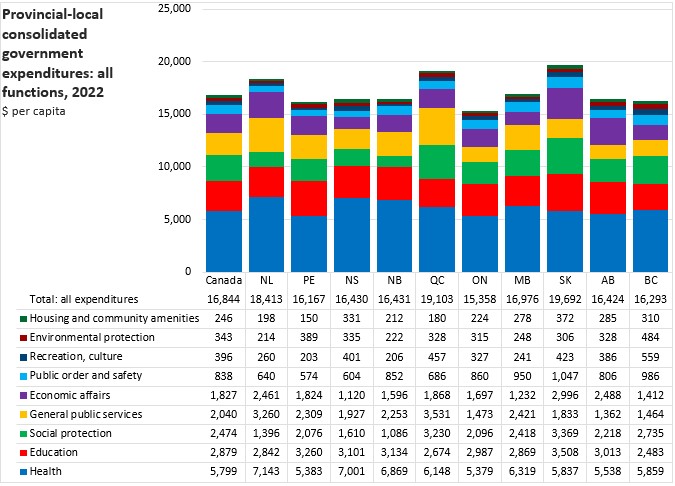

In the last year, Nova Scotia's per capita consolidated expenditures on provincial-local government functions increased by $897 per capita or 5.8%. National expenditures increased by $319 per capita or 1.9%. The fastest growth was in New Brunswick (+9.9% or +$1,474 per capita) and Newfoundland and Labrador (+8.6% or +$1,458 per capita). Saskatchewan (-2.8% or -$567 per capita) and Alberta (-0.5% or -$88 per capita) reported the only declines in per capita spending.
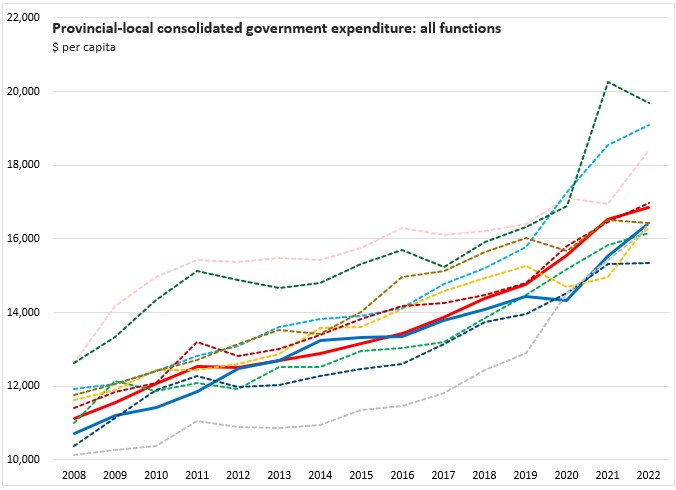
Health care makes up the largest per capita expenditure function in every provincial-local government. Nova Scotia's health expenditures of $7,001 per capita were above the national average of $5,799 per capita. Hospitals and outpatient services make up the bulk of health care spending. Nova Scotia's per capita expenditures were the second highest for hospitals ($4,879 per capita) and highest for public health services ($599 per capita) but lower for outpatient services ($796 per capita) and medical equipment and appliances ($307). The highest health expenditures were reported in Newfoundland and Labrador while the lowest were reported in Ontario and Prince Edward Island.
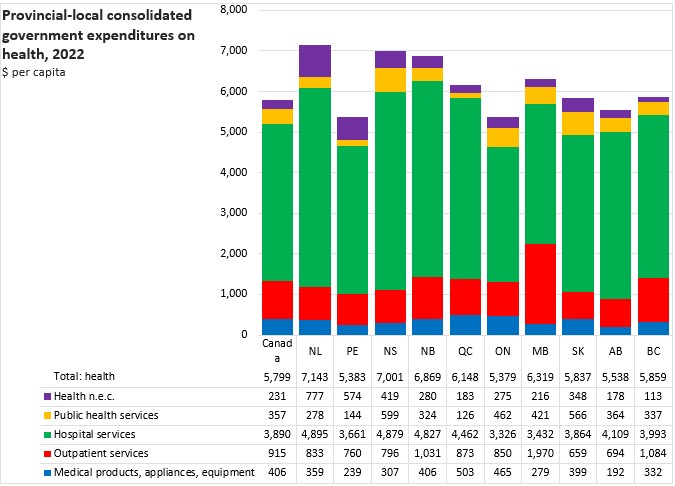
Note: n.e.c. refers to expenditures "not elsewhere classified".
Nova Scotia's per capita health expenditures have grown rapidly in the last two years and are now the second highest among provinces - just behind those of Newfoundland and Labrador and just ahead of those in New Brunswick. In 2022, Nova Scotia's health expenditures per capita grew by 5.4% or $361 per capita. New Brunswick's expenditures were the fastest growing at +15.6% or +$926 per capita while Québec (-0.2% or -$14 per capita) and Saskatchewan (-0.4% or -$25 per capita) reported the only declines in per capita health expenditures. National per capita health expenditures were up 2.6% or $149 per capita from 2021 to 2022.
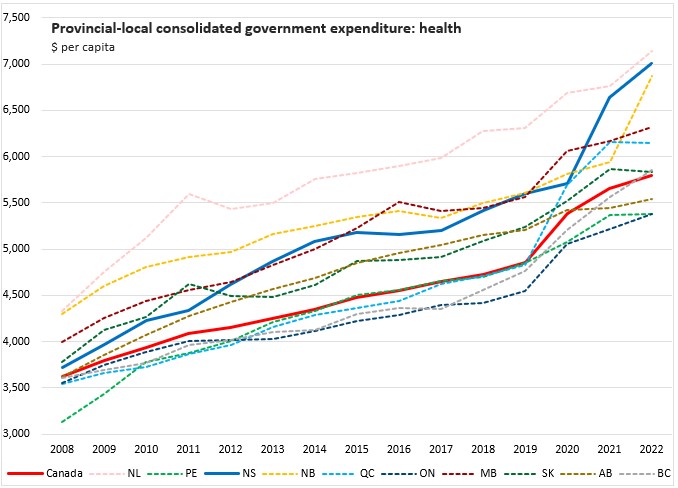
Education is the second largest functional expenditure made by provincial-local governments. Nova Scotia's education spending of $3,101 per capita was above the national average among provincial-local governments ($2,879 per capita). Nova Scotia's spending on universities ($1,082 per capita) was the highest among provinces. Nova Scotia's expenditures for primary/secondary education ($1,696 per capita) and colleges ($300 per capita) were below the national per capita averages. Per capita education spending was highest in Saskatchewan and lowest in British Columbia.
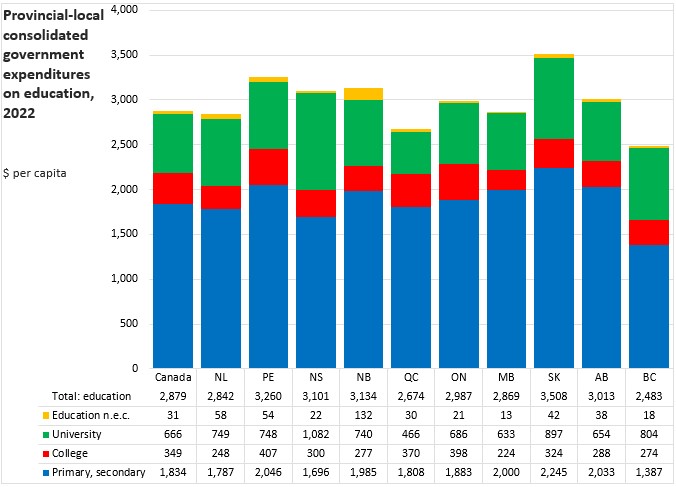
Nova Scotia's per capita education spending increased by 14.3% or $387 per capita from 2021 to 2022 - the fastest gain among provinces. National education expenditures increased by 1.6% ($45 per capita) with the Québec and Saskatchewan reporting the only declines.
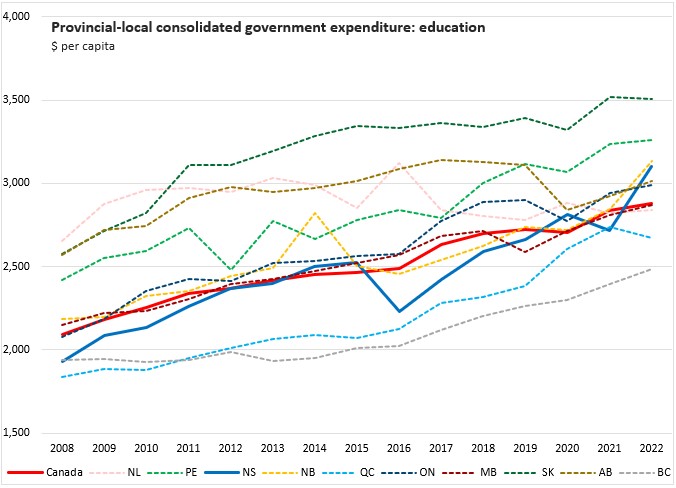
Provincial-local government consolidated expenditures on social protection amounted to $1,610 per capita in Nova Scotia - lower than the national average of $2,474 per capita. Expenditures on social protection exhibit a wide variation across Canada, with over $2,200 per capita difference from the lowest spending provincial-local government (New Brunswick) to the highest (Saskatchewan). Some of this variation is explained by markedly different service levels across provinces. For example, Saskatchewan's higher payments for sickness and disability are attributable to benefits provided under that province's public auto insurance program.
Sickness/disability payments make up the largest portion of social protection expenditures in most jurisdictions, followed in some by children/family services and in others by expenditures to address social exclusion (including funding for low-income earners, refugees and homeless persons).
Nova Scotia's expenditures on sickness/disability ($613 per capita), social exclusion ($392 per capita) and family/children ($327 per capita) were below the national averages for these functions. Nova Scotia's per capita expenditures on housing for social protection were $272 per capita - above the national average.
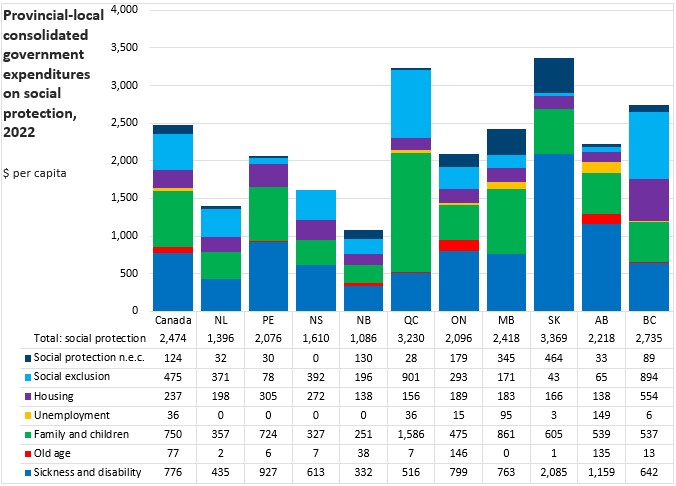
Consolidated provincial-local expenditures on social protection increased by 12.9% (+$184 per capita) in Nova Scotia from 2021 to 2022. National expenditures increased by 6.0% (+$139 per capita) with the largest gains in Prince Edward Island (+35.1% or +$540 per capita) and Saskatchewan (+23.0% or +$629 per capita). Only Ontario (-3.0% or -$66 per capita) reported lower expenditures on social protection in 2022.
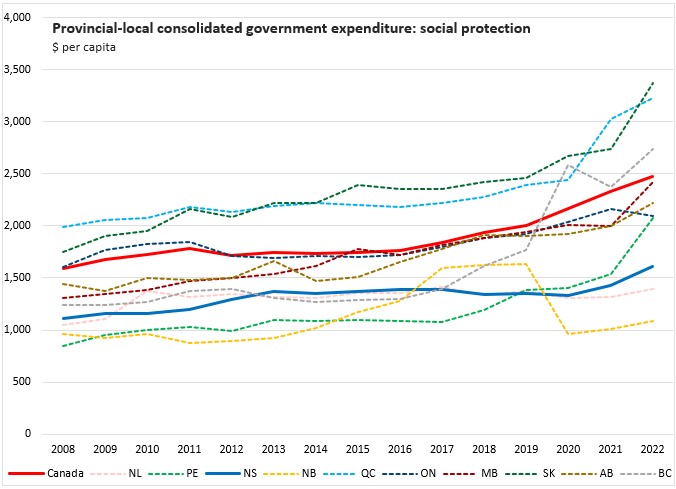
General public service expenditures (consolidated provincial-local) were $1,927 per capita in Nova Scotia, including $743 per capita in public debt transactions, $557 per capita in general provincial-local government services and $370 per capita in executive/legislative/financial/fiscal affairs. Nova Scotia's general public service expenditures are below the national per capita average ($2,040). The highest expenditures on general public services were in Newfoundland and Labrador as well as Quebec. The lowest general public service expenditures were in Alberta, British Columbia and Ontario (followed by Nova Scotia).
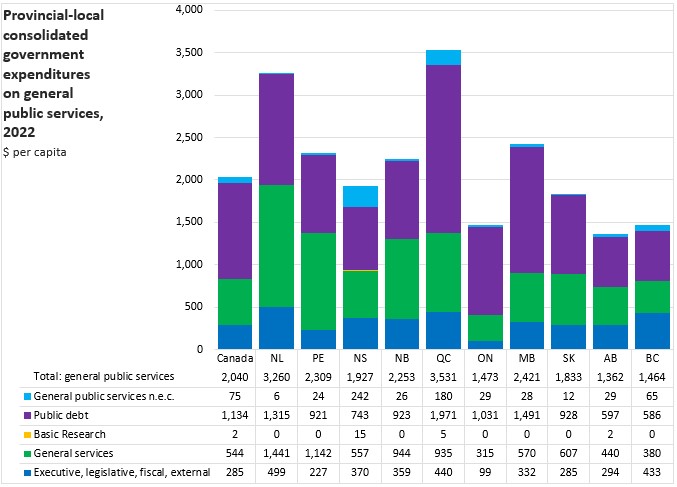
In 2022, Nova Scotia's consolidated provincial-local expenditures on general public services increased by 6.0% or +$110 per capita.
Across Canada, provincial-local consolidated expenditures on general public services were up 4.2% or +$82 per capita. The largest decline was reported in Prince Edward Island (-8.7% or -$220 per capita). The largest rise in general public services expenditures was reported in Saskatchewan (+10.1% or +$168 per capita).
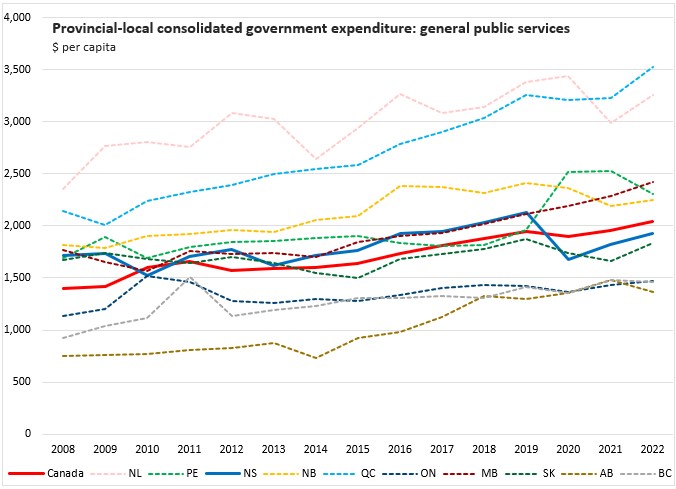
The economic affairs functional category includes expenditures in a wide range of activities. Transportation is the largest provincial-local exepnditure on economic affairs across Canada, but it is not the largest expenditure in Alberta (fuel and energy) and Saskatchewan (agriculture, forestry, fishing, hunting) and Nova Scotia (general economic/commercial/labour affairs).
Overall per capita spending on economic affairs in Nova Scotia was $1,120 - the lowest among provinces. Nova Scotia's expenditures on transportation ($487 per capita) were the second lowest among provinces. The highest expenditures on economic affairs were in Saskatchewan and Alberta, with high crop insurance payments as well as large expenditures on the economic affairs of fuel and energy. The national average spending on economic affairs was $1,827 in 2022.
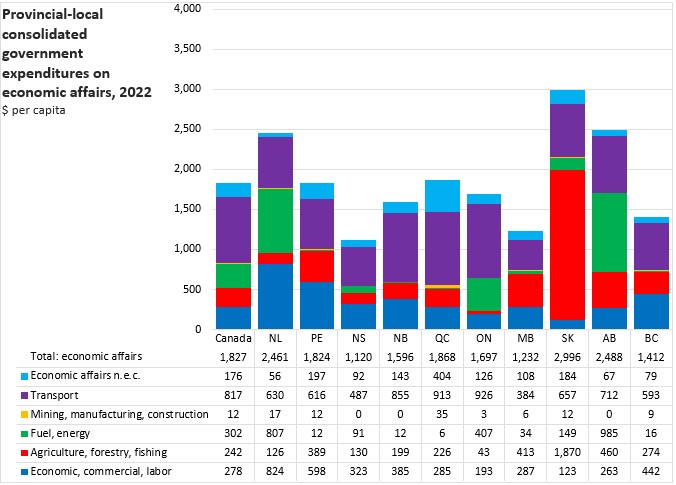
From 2021 to 2022, Nova Scotia's consolidated provincial-local expenditures on economic affairs (including transportation) contracted by 4.3% or -$51 per capita. National expenditures fell by 7.7% or -$152 per capita. Saskatchewan reported a large contraction (-28.0% or -$1,166 per capita) after a sharp rise in 2021. Newfoundland and Labrador (+42.7% or +$736 per capita) reported the largest gain in spending on economic affairs.
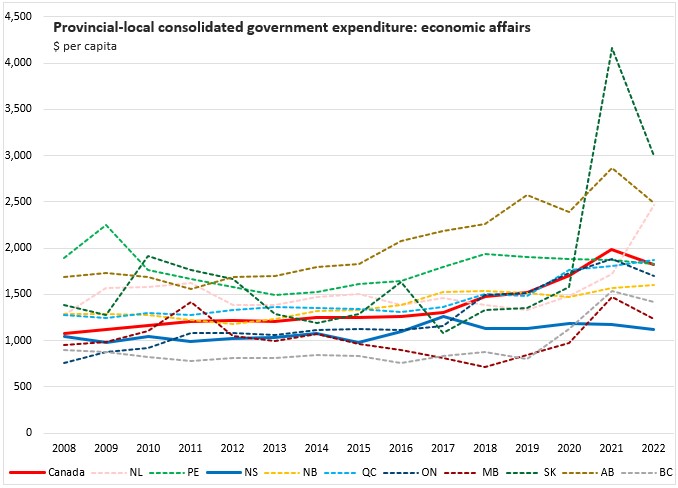
Expenditures on public order and safety were $838 per capita in Canada and $604 per capita in Nova Scotia in 2022. Police services made up the largest part of these expenditures, followed by law courts and fire protection services. The highest expenditures on public order and safety were reported in Saskatchewan. The lowest expenditures on public safety were in Prince Edward Island. Nova Scotia's expenditures on public safety were below the national averages for police services, fire protection and prisons, but higher for law courts.
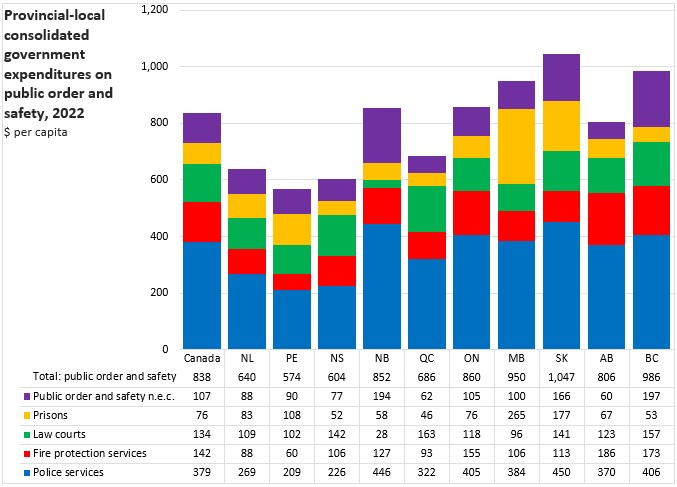
Nova Scotia's consolidated provincial-local expenditures on public order and safety fell by 11.5% or -$78 per capita from 2021 to 2022, the second consecutive year of substantial decline and the largest decline among provinces. Across Canada, these expenditures were up 3.0% or +$25 per capita. The largest increases in public order and safety spending were reported in New Brunswick (+7.5% or +$59 per capita) and British Columbia (+6.3% or +$58 per capita).
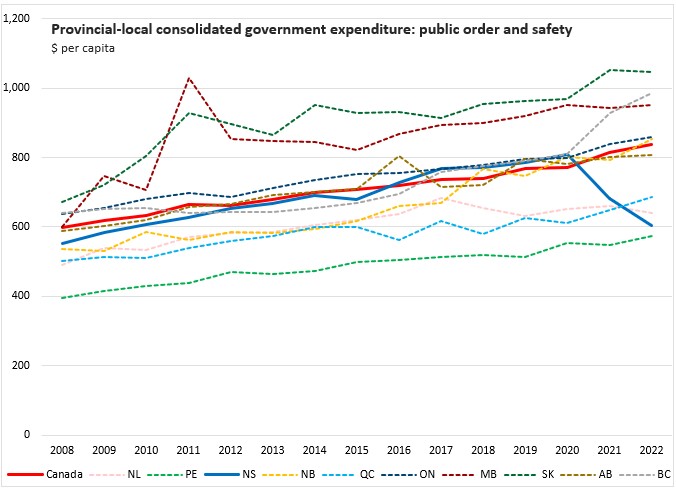
Spending on recreation and cultural services was $396 per capita across Canada and $401 per capita in Nova Scotia. Recreation and culture spending was higher in British Columbia, which has a larger expenditure on broadcasting/publishing services. Prince Edward Island and New Brunswick had the lowest spending on recreation and cultural services.
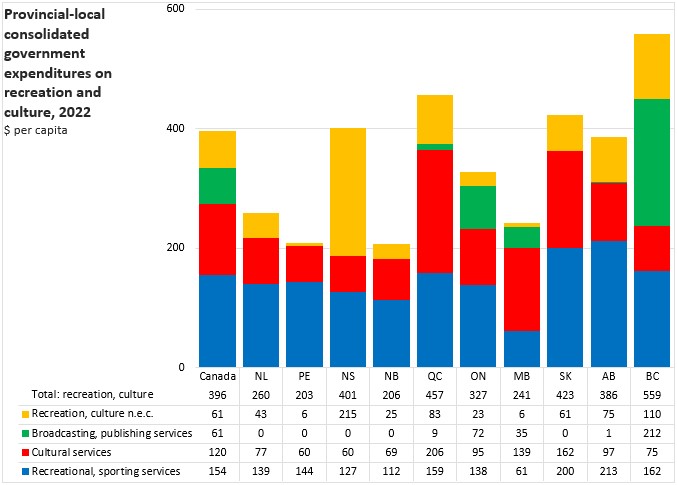
National consolidated provincial-local spending on recreation and culture was up 2.5% or +$10 per capita from 2021 to 2022. The largest gain was reported in British Columbia (+14.7% or +$72 per capita) while Prince Edward Island reported the largest decline (-19.6% or -$50 per capita). Nova Scotia's expenditures on recreation and culture decreased by 2.7% or +$11 per capita.
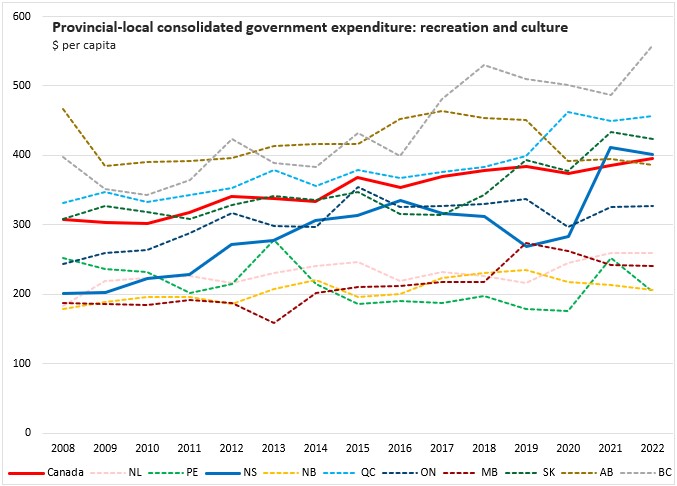
National consolidated provincial-local spending on environmental protection was $343 per capita in 2022. Nova Scotia's expenditures on environmental protection were $335 per capita. Waste management and waste water management typically make up the largest portions of national expenditures on environmental protection. Nova Scotia and Prince Edward Island reported the highest expenditures on waste management while British Columbia and Ontario spent the most on waste water management.
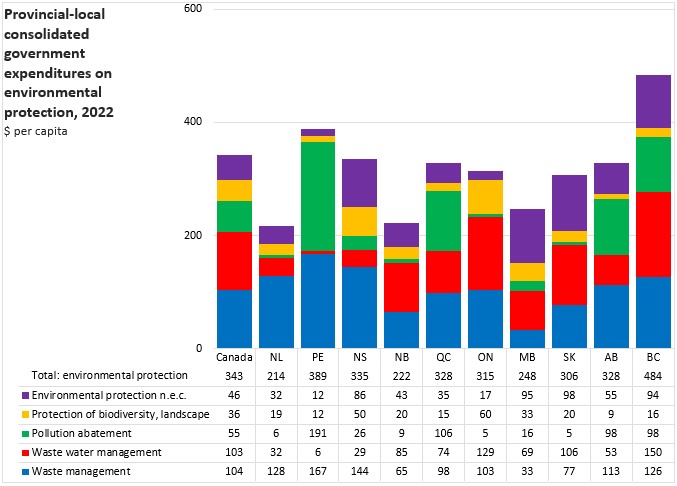
From 2021 to 2022, there was a decline in consolidated provincial-local expenditures on environmental protection reported in Nova Scotia (-7.3% or +$27 per capita) while national expenditures rose by 4.3% or $14 per capita. British Columbia expenditures on environmental protection were up by the most at 29.8% or $111 per capita while Saskatchewan (-8.5% or -$29 per capita) and Nova Scotia reported the largest declines.
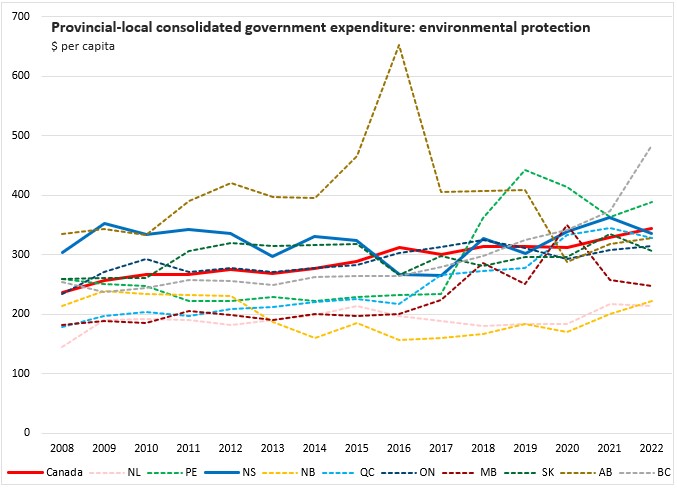
Consolidated provincial-local spending on housing and community amenities amounted to $246 per capita nationally and $331per capita in Nova Scotia. Provision of water supply makes up the largest part of housing/community amenity spending in most provinces. Nova Scotia made the highest expenditures on street lighting among provinces ($41 per capita). There was a large increase in Nova Scotia provincial-local housing and community expenditures not elsewhere classified, which pushed the province's per capita expenditures to the second highest in Canada.
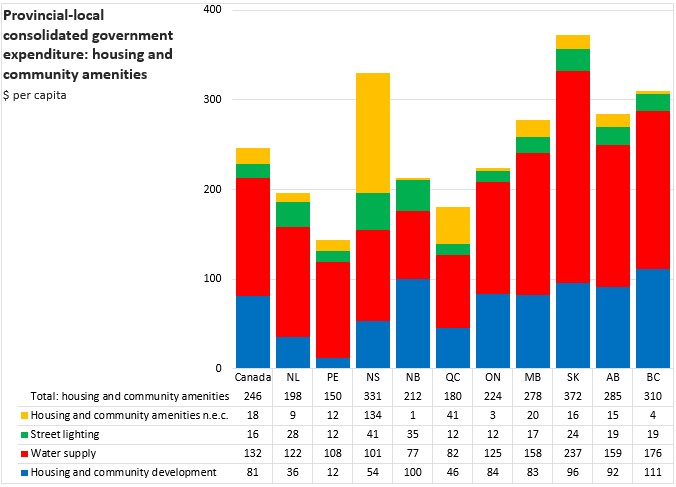
From 2021 to 2022, Nova Scotia reported a second consecutive gain in consolidated provincial-local expenditures per capita on housing and community amenities (+7.0% or +$22 per capita). National expenditures on housing and community amenities were up 3.3% or +$8 per capita. Quebec reported the largest growth in spending on housing and community amenities (+25.1% or +$36 per capita) while Saskatchewan reported the largest decline (-23.9% or -$116 per capita).
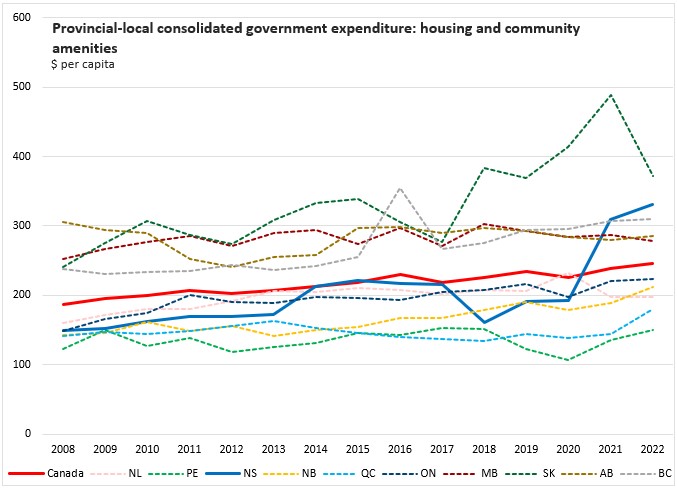
Statistics Canada. Table 10-10-0005-01 Canadian Classification of Functions of Government (CCOFOG) by consolidated government component (x 1,000,000), Table 17-10-0005-01 Population estimates on July 1st, by age and sex
<--- Return to Archive